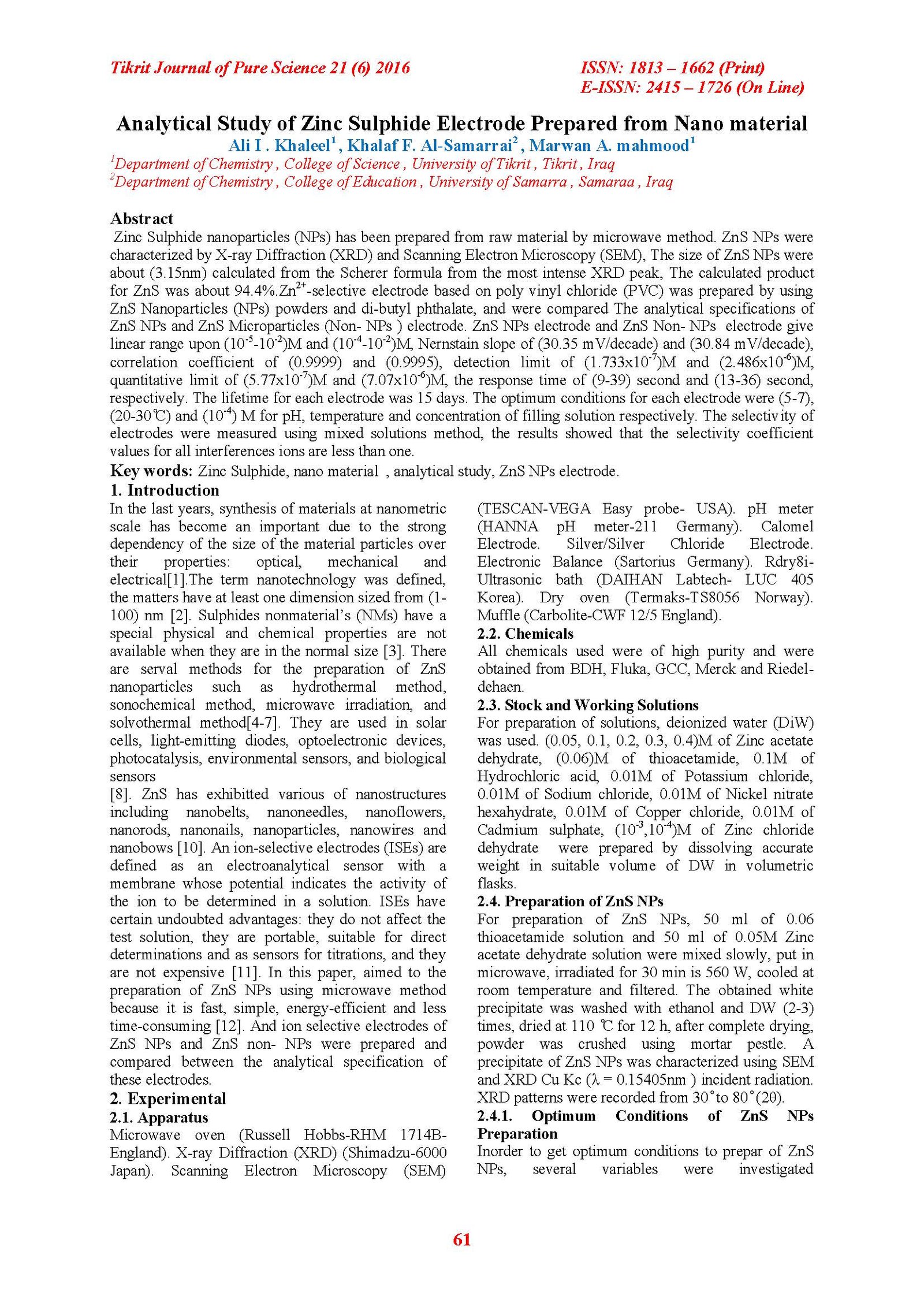Analytical Study of Zinc Sulphide Electrode Prepared from Nano material
Main Article Content
Abstract
Zinc Sulphide nanoparticles (NPs) has been prepared from raw material by microwave method. ZnS NPs were characterized by X-ray Diffraction (XRD) and Scanning Electron Microscopy (SEM), The size of ZnS NPs were about (3.15nm) calculated from the Scherer formula from the most intense XRD peak, The calculated product for ZnS was about 94.4%.Zn2+-selective electrode based on poly vinyl chloride (PVC) was prepared by using ZnS Nanoparticles (NPs) powders and di-butyl phthalate, and were compared The analytical specifications of ZnS NPs and ZnS Microparticles (Non- NPs ) electrode. ZnS NPs electrode and ZnS Non- NPs electrode give linear range upon (10-5-10-2)M and (10-4-10-2)M, Nernstain slope of (30.35 mV/decade) and (30.84 mV/decade), correlation coefficient of (0.9999) and (0.9995), detection limit of (1.733x10-7)M and (2.486x10-6)M, quantitative limit of (5.77x10-7)M and (7.07x10-6)M, the response time of (9-39) second and (13-36) second, respectively. The lifetime for each electrode was 15 days. The optimum conditions for each electrode were (5-7), (20-30 ̊C) and (10-4) M for pH, temperature and concentration of filling solution respectively. The selectivity of electrodes were measured using mixed solutions method, the results showed that the selectivity coefficient values for all interferences ions are less than one.
Article Details

This work is licensed under a Creative Commons Attribution 4.0 International License.
Tikrit Journal of Pure Science is licensed under the Creative Commons Attribution 4.0 International License, which allows users to copy, create extracts, abstracts, and new works from the article, alter and revise the article, and make commercial use of the article (including reuse and/or resale of the article by commercial entities), provided the user gives appropriate credit (with a link to the formal publication through the relevant DOI), provides a link to the license, indicates if changes were made, and the licensor is not represented as endorsing the use made of the work. The authors hold the copyright for their published work on the Tikrit J. Pure Sci. website, while Tikrit J. Pure Sci. is responsible for appreciate citation of their work, which is released under CC-BY-4.0, enabling the unrestricted use, distribution, and reproduction of an article in any medium, provided that the original work is properly cited.
References
[1] S. Murugesan, T. Park, H. Yang, S. Mousa and R. J. Linhardt, Langmuir 22(8) (2006) 3461-3463.
[2] D. Shailaja, M. Shailaja, P. Roselin, J. Manasa and N. Shalini, Int. J. Bioassays 2(6)(2013)914-917.
[3] B. Gilbert, F. Huang, H. Zhang, GA. Waychunas and JF. Banfield, Science, 305(5684)(2004) 651-654.
[4] L. Zhang, D. Qin, G. Yang, and Q. Zhang, Chalcogenide Letter 9 (93) (2012). [5] L. Chai, J. Phys, Y. Zhu, H.Li,S. Xiong,Y, Qian. Chem. C. 111 (12658) (2007). [6] J. Q. Sun, X. P. Shen, K. M. Chen, Q. Liu, and W. Liu. Solid State Commun. 147(501) (2008).
[7] L. Wang, L. Chen, T. Luo, and Y. Qian, Mater Lett. 60 (3627) (2006).
[8] N. Ghows M.H. Entezari, Ultrason Sonochem. 18 (269) (2010).
[9] M. Kooti and A.N. Sedeh, J. of Chemistry 2013 (2013) 1-4
[10] A. Eftekhari, F. Molaei and H. Arami, Materials Science and Engineering A 437 (2) (2006) 446-450
[11] J. Koryta, J. Annu. Rev. Mater. Sci. 16 (1986) 13-27
[12] A. Roy and J. Bhattacharya, International Journal of Nanoscience 10 (3) (2011) 413-418
[13] M. Lashanizadegan and H. Mirzazadeh, Journal of Ceramic Processing Research 13 (4) (2012) 389-391
[14] P.L. Bailey, Analysis with ion selective electrodes, Heyden international topics in science, London, 2nd edition (1980).
[15] P. Grundler, Chemical sensors, an introduction for scientists and engineers, Springer- Verlag, Berlin, Heidelberg (2007) .
